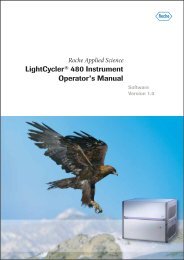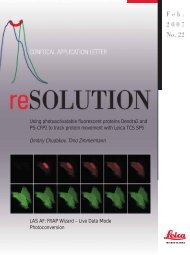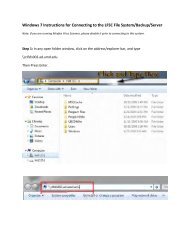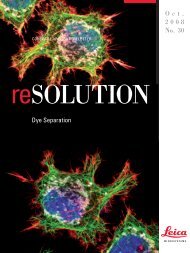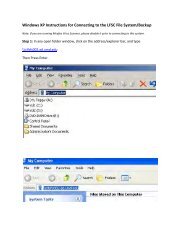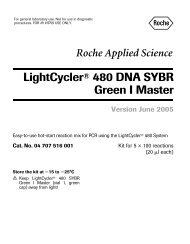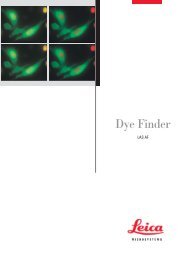Application note: White Light Laser - Department of Cell Biology and ...
Application note: White Light Laser - Department of Cell Biology and ...
Application note: White Light Laser - Department of Cell Biology and ...
You also want an ePaper? Increase the reach of your titles
YUMPU automatically turns print PDFs into web optimized ePapers that Google loves.
D y e S e p a r a t i o n<br />
Fig 7: Top: excitation at the peak <strong>of</strong> absorption (here with 561 nm<br />
from a DPSS laser) is restricting the b<strong>and</strong> for emission collection.<br />
Therefore, it might be beneficial to use a line that excites on<br />
the blue slope. Bottom: for Alexa 546, this could be the HeNe 543<br />
nm line. Unfortunately, this line is very weak <strong>and</strong> not efficient for<br />
a cross section <strong>of</strong> only 50%.<br />
Fig 8: Tunable excitation <strong>and</strong> ample power density allows to<br />
optimize the excitation wavelength <strong>and</strong> the collection b<strong>and</strong> for<br />
emission.<br />
Nevertheless, this is not necessarily the best<br />
position <strong>of</strong> excitation. In order to avoid excitation<br />
light to enter the detector, a certain “securitydistance”<br />
has to be kept between excitation <strong>and</strong><br />
the blue edge <strong>of</strong> the emission b<strong>and</strong> that is collected.<br />
If the stokes shift is rather low, then the<br />
residual window for emission collection might<br />
cut <strong>of</strong>f a significant part <strong>of</strong> the available photons,<br />
which is not desirable. So it sometimes does indeed<br />
make sense to excite the dye somewhat<br />
<strong>of</strong>f the peak in the blue range (Alexa 488 case)<br />
<strong>and</strong> compensate for the lesser absorption by increasing<br />
the laser intensity. Then you can collect<br />
the full emission spectrum.<br />
With the Leica tunable laser source you may also<br />
find a more efficient excitation for Alexa 546, <strong>and</strong><br />
get better images at e.g. 555 nm. Just try out <strong>and</strong><br />
evaluate the best settings during a few scans<br />
online!<br />
The combined operation <strong>of</strong> tunable excitation<br />
<strong>and</strong> tunable emission can help to find the best<br />
setting for excitation <strong>and</strong> emission: a s<strong>of</strong>tware<br />
tool is available, that acquires images at incrementing<br />
excitation wavelength (excitation scan)<br />
<strong>and</strong> also adjusts automatically the blue cut-<strong>of</strong>f <strong>of</strong><br />
the emission b<strong>and</strong>, for example always 10 nm <strong>of</strong>f<br />
the excitation to avoid reflected light to enter the<br />
detector.<br />
Furthermore, the environment in which the sample<br />
is surrounded will sometimes shift excitation.<br />
In some cases, specific dyes have been developed<br />
to exploit this phenomenon (pH or Ca +2<br />
dyes). Here, with the tunable laser you can adapt<br />
to these alterations <strong>and</strong> ensure optimal excitation<br />
under any circumstances.<br />
Confocal <strong>Application</strong> Letter 7




